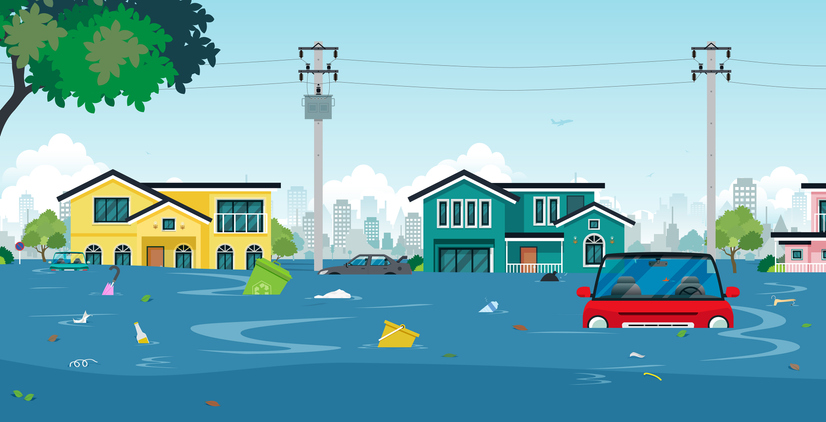Technologies To Protect Your Home Against Extreme Weather
With storms, floods and wildfires a mounting concern for many homeowners, building experts look ahead at ways to prepare.
Threats from hurricanes, wildfires and tornadoes are a growing concern for many homeowners looking for ways to protect their properties—especially as some scientists report that extreme weather events will likely continue to have far-reaching consequences in coming years.
New technologies are emerging. Companies are developing innovative roof systems such as one made by Tesla Inc. that aim to handle high winds and punishing hail. For new homes, novel uses of concrete, including a method that squeezes it out in layers like toothpaste, offer sturdy alternatives to wood-frame construction. “The Romans had concrete, but the way we’re using it by doing 3D printing is new,” says architect Rose Grant.
Homeowners contemplating some of the more cutting-edge approaches to shoring up their homes could be looking at hefty price tags—meaning they will need to weigh potential benefits against costs. And because most American homes are older than 10 years, retrofits will be key, industry experts say.
In the face of weather and climate threats in coming decades, the best advice remains avoiding coasts, floodplains or forests as home sites, says Nicholas Rajkovich, a University at Buffalo associate professor of architecture.
But for those looking to fortify their homes, here are coming options and the latest expert advice:
Roofs Go High-Tech
Solar roof systems are among the newest offerings for homeowners, billed as offering sturdy protection while also generating power. These non-traditional roofs combine sleek aesthetics and environmental sustainability with disaster resilience, building experts say.
Tesla Inc. is among the companies making a solar roof system that features strong glass tiles embedded with solar cells. Tesla says its roof, constructed with a combination of glass solar tiles, glass roofing tiles and architectural-grade steel tiles, has the top fire rating, second-highest hail rating and can withstand 110-mph winds. Costs vary by roof size, a Tesla representative says. Ivan Gould, a real estate agent in Sarasota, Fla., says the Tesla roof on his 2,400-square-foot home cost $41,500 after a tax credit.
GAF Energy, part of privately held Standard Industries, this year launched a roof system that it says directly integrates solar technology into traditional roofing processes and materials. The company says the system uses the world’s first nailable solar shingle and has the same fire and wind ratings as Tesla’s roof.
Seal the Roof Deck
As too often seen in recent disasters, severe weather can take off a roof’s shingles, allowing rain to pour through gaps in the underlying roof deck and destroy the home’s interior. An unsealed roof deck allows up to 60% of falling rain to enter the attic, the Insurance Institute for Business and Home Safety says.
Here, a tried-and-true fix can make a big difference. Sealing the roof deck is relatively easy, and can reduce water entry by as much as 95%, the insurance institute says. One method is to cover seams with flashing tape, then top the deck with a reinforced synthetic material. The roof deck of a 2,000-square-foot home could be sealed for as little as $500, the institute says.
3D-Printed Walls
Most houses are “stick built” with wood frames, yet some builders are shifting to concrete to build stronger walls. Austin-based Icon Technology Inc. says it has used 3D printing to build more than two dozen homes and other structures. A 46.5-foot-wide gantry-style printer dispenses a concrete mix, layer by layer, to form walls at a home site. The computer-driven process can save time and money, and yield a structure whose exterior won’t burn or rot and that can withstand extreme weather better than conventional wood-frame homes, says Bungane Mehlomakulu, Icon’s head of building performance. Compared with other types of construction, 3D printing can more easily create curved walls that allow high winds to flow past, he says.
Iowa-based Alquist 3D, which focuses on affordable housing, says it plans to print hundreds of homes over the next three years. Black Buffalo 3D Corp., which supplies Alquist’s material and printers, says its proprietary concrete mixture cures to a compressive strength of 7,500 pounds per square inch, well above the global wall-strength standards range of 2,500 to 4,000 PSI.
Ignition-Free Zones
Increasingly intense and destructive wildfires have focused attention on efforts needed to mitigate risks for homeowners—and is bolstering a growing idea that joint neighborhood efforts can be more effective than those of individuals. Embers and small flames cause a majority of homes to ignite during wildfires, the nonprofit National Fire Protection Association says. Many of the prescriptions remain basic: To lower risks, homeowners in fire-prone areas should clear potential fuels—anything that can burn—up to 200 feet from the house, the group says. The most critical zone is the 5-foot perimeter around the home.
Remove dead leaves from roofs and gutters. Enclose areas under decks with wire mesh to keep out debris. Move anything that might catch fire, including plants, away from exterior walls. Tree placement is also key, the association says. Branches and leaves should be at least 10 feet away from the house, and there should be more space between trees closest to the dwelling.
Protect the Entry Points
Windows are vulnerable in a wildfire, and heat from burning trees can shatter the glass before a home ignites. Double-paned windows, with one pane of tempered glass, can reduce the risk, according to Home Innovation Research Labs, an independent subsidiary of the National Association of Home Builders. Finding ways to make windows more resistant to heat and flame is a major focus of research in the homebuilding industry that is expected to bring new products in coming years.
Embers and flames that enter through a vent can ignite a house from within, so it is important to seal off potential entry points, usually found on the roof, around crawl spaces and on the undersides of eaves. Covering vents with ⅛-inch metal mesh screen can block embers big enough to start a fire, the Insurance Institute for Business and Home Safety says.
Insulate With Concrete
With roots in post-World War II Switzerland, a method known as “insulating concrete forms” is winning plaudits from safety experts for its strength and gaining a higher profile as efforts ramp up to find ways to fend off severe weather. Canada-based Nudura Inc., says structures built with its ICFs can resist winds up to 250 mph, equivalent to an F4 tornado.
Several companies make these forms, which can be stacked along exterior walls like Lego blocks. The forms consist of two layers of insulation material separated by a void several inches wide. Concrete is poured into that gap, creating a concrete-filled sandwich.
Mike Russell, a Nudura technical sales representative, says his 2,500-square-foot ICF house near St. Augustine, Fla., emerged unscathed from Hurricane Michael in 2016 and a tornado in 2017. While the house cost 5% more to build than a traditional home, he says, the insulating effects keep his electric bill around $40 to $50 a month, even in summer.
Let the Water In
In a counterintuitive idea, building experts say allowing part of your house to flood could help you protect it. Using a technique known as “wet floodproofing,” small rectangular openings can be added to foundation and garage walls, below the expected flood level. If flood waters allowed to enter a home’s enclosed area can quickly reach the same level as flood waters outside, the destructive effects of hydrostatic pressure are reduced, according to the Federal Emergency Management Agency. This can help limit damage to the foundation and other parts of the house.
“You just allow your basement to flood, so that you can clean it up later,” said Nicholas Rajkovich, a University at Buffalo associate professor of architecture. This, of course, would require putting the furnace, hot water tank and other appliances at higher levels. And, to be sure, it’s best for basements, garages and other areas not used as living space.
Beware the Garage
The garage door is typically the largest opening in a home’s building envelope, and if it breaks open during a hurricane or tornado, the rapid buildup of air pressure inside can “literally rip the roof off the house,” says John Peavey, who directs the building-science division at Home Innovation Research Labs. He recommends a reinforced garage door, which some local codes require. Impact-resistant windows and skylights will also help prevent blowouts, as do hurricane shutters.
Extra protection against wind can add 20%-30% to a garage door’s cost, according to Mischa Fisher, chief economist at Angi, formerly Angie’s List.
Reprinted by permission of The Wall Street Journal, Copyright 2021 Dow Jones & Company. Inc. All Rights Reserved Worldwide. Original date of publication: April 12, 2022.
 Copyright 2020, Dow Jones & Company, Inc. All Rights Reserved Worldwide. LEARN MORE
Copyright 2020, Dow Jones & Company, Inc. All Rights Reserved Worldwide. LEARN MORE
This stylish family home combines a classic palette and finishes with a flexible floorplan
Just 55 minutes from Sydney, make this your creative getaway located in the majestic Hawkesbury region.
Former Google CEO Eric Schmidt is selling his Northern California estate, which was listed Monday for $24.5 million.
Located in Atherton, an extremely affluent town northwest of Palo Alto and about 30 miles south of San Francisco, the 3.36-acre property is made up of three parcels that Schmidt acquired over the years, according to public records and Compass, who has the listing.
Schmidt, 69, and his wife, businesswoman Wendy Schmidt, purchased the main home in 1990 for $2 million, according to public records accessed via PropertyShark. They remodelled the 1969 home in 2007, and at that time, bought a neighbouring parcel of land, allowing an expansion of the main house and the addition of a guest house, according to Compass, who holds the listing. A third parcel was later acquired, on which the Schmidts added an English garden house and landscaped grounds overlooking the Eastern Hills.
“Finding three contiguous parcels in Atherton is rare. Even rarer are those with views of the Eastern hills,” said listing agent Katharine Carroll of the reSolve Group at Compass. “The location of this residence is ultra private, at the back of a cul-de-sac with the main house built into a hillside that provides privacy and very good security.”
Across the estate, there are five bedrooms, five full bathrooms and six half bathrooms.
The 5,265-square-foot main house also offers a number of private outdoor spaces on its upper level, including a large terrace off the primary suite, another large terrace off a secondary bedroom, plus a third smaller terrace and two balconies.
Behind the main house is a patio with a pool and spa. For even more outdoor space, there’s an entertaining pavilion, an open lawn and an outdoor fireplace area near the guest quarters.
The grounds themselves are also a standout feature, with an array of mature plants and specimen trees. The upper portion of the property’s landscaping is designed around an Amdega-designed conservatory, which was imported from the U.K. Around the greenhouse, there is a garden of raised beds and fruit trees, Carroll said.
“From the moment you step onto the grounds, it feels as if you’ve been transported to a private botanical sanctuary,” she said.
Schmidt served as Google’s CEO from 2001 to 2011, and then became the company’s executive chairman until 2015. He could not be reached for comment.
This article first appeared on Mansion Global
This stylish family home combines a classic palette and finishes with a flexible floorplan
Consumers are going to gravitate toward applications powered by the buzzy new technology, analyst Michael Wolf predicts























